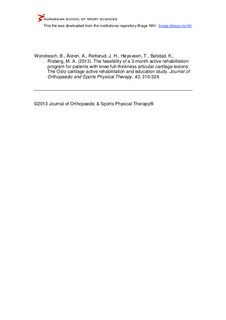| dc.description.abstract | Study Design
Case series.
Objectives
To evaluate the feasibility of an active rehabilitation program for patients with knee full-thickness articular cartilage lesions.
Background
No studies have yet evaluated the effect of active rehabilitation in patients with knee full-thickness articular cartilage lesions or compared the effects of active rehabilitation to those of surgical interventions. As an initial step, the feasibility of such a program needs to be described.
Methods
Forty-eight patients with a knee full-thickness articular cartilage lesion and a Lysholm score below 75 participated in a 3-month active rehabilitation program consisting of cardiovascular training, knee and hip progressive resistance training, and neuromuscular training. Feasibility was determined by monitoring adherence to the program, clinical changes in knee function, load progression, and adverse events. Patients were tested before and after completing the rehabilitation program by using patient-reported outcomes (Knee injury and Osteoarthritis Outcome Score, International Knee Documentation Committee Subjective Knee Evaluation Form 2000) and isokinetic muscle strength and hop tests. To monitor adherence, load progression, and adverse events, patients responded to an online survey and kept training diaries.
Results
The average adherence rate to the rehabilitation program was 83%. Four patients (9%) showed adverse events, as they could not perform the exercises due to pain and effusion. Significant and clinically meaningful improvement was found, based on changes on the International Knee Documentation Committee Subjective Knee Evaluation Form 2000, the Knee injury and Osteoarthritis Outcome Score quality of life subscale, isokinetic muscle strength, and hop performance (P<.05), with small to large effect sizes (standardized response mean, 0.3–1.22).
Conclusion
The combination of a high adherence rate, clinically meaningful changes, and positive load progression and the occurrence of only a few adverse events support the potential usefulness of this program for patients with knee full-thickness cartilage lesions. This study was registered with the public trial registry Clinical Trials.gov (NCT00885729). | nb_NO |
